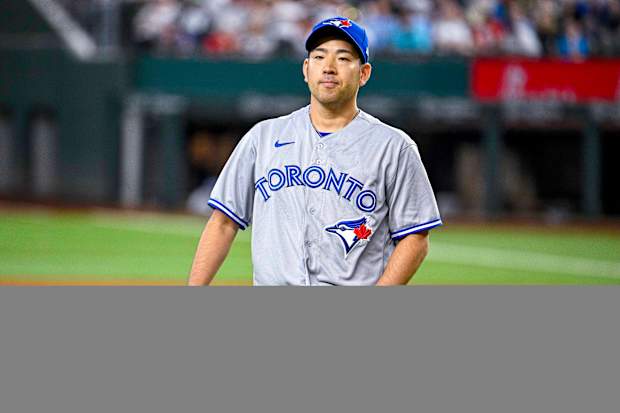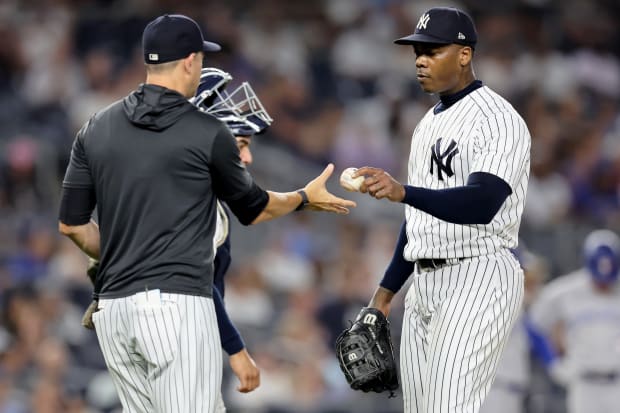Sometimes baseball players age gracefully and retire on their own terms. Hall of Famers David Ortiz and Chipper Jones are among that lucky cohort. The vast majority of them, however, fall off the radar before you even realize they’re gone.
In 2018, Scooter Gennett was a National League All-Star. After struggling for the Reds and Giants the following year, he never signed with a major league team again. Wilson Ramos, Mitch Moreland, Shin-Soo Choo and Mike Foltynewicz are just a few others who were All-Stars four years ago and have long been off any MLB roster. It’s hard to discern when any player’s talent is no longer major-league caliber, but it’s a key skill to have for front offices trying to differentiate between a veteran who could end up as a bargain-bin signing and a player who’s already turned into a pumpkin.
Hunter Dozier landed himself on the first edition of Pumpkin Watch last year by showing alarming signs of decline just months after signing a four-year, $25 million extension in March 2021. This season, the 31-year-old has measured as MLB’s worst qualified hitter in terms of FanGraphs WAR and will almost certainly be cut loose by Kansas City in the offseason. It’d be surprising if he’s handed a guaranteed major-league contract with another team, at least before the ’23 campaign.
The names below haven’t quite progressed to that unfortunate stage of baseball’s life cycle, but their career clocks seem far closer to striking midnight than they did entering this season. With the first official day of fall arriving Thursday, let’s examine four struggling former All-Stars who could be turning into pumpkins right before our eyes.
Nick Castellanos, Phillies RF/DH
While Castellanos has managed to maintain his penchant for hitting the occasional poorly (read: incredibly) timed home run, he otherwise has not lived up to his reputation as a slugger in the first season of his five-year, $100 million contract with Philadelphia.
With a slash line of .265/.305/.397 and just 13 home runs, Castellanos is sporting a career-worst 96 OPS+ (excluding his 11-game cameo in 2013), meaning he’s been 4% worse than the league-average hitter. His average exit velocity, barrel rate and walk rate are also at career lows. The 30-year-old has taken his streaky tendencies to new lengths, as he’s had two homerless streaks that have lasted at least a month (May 30 to June 30, June 30 to Aug. 3). And he certainly hasn’t made up for any of this with his typically shoddy defense in right field, where he’s had to play far more often than originally planned due to Bryce Harper’s elbow injury. Put it all together and he’s been the second-worst right fielder among 21 qualified players with -0.7 fWAR, ahead of only our friend Hunter Dozier. Castellanos has not played since Sept. 2, when he left Philadelphia’s 5–4 loss to the Giants in the sixth inning with an oblique strain and was placed on the injured list shortly thereafter.
Castellanos’s struggles at the plate come in stark contrast to last year, his second season with the Reds, when he made his first All-Star team and set career-best marks in batting average (.309), on-base percentage (.362) and slugging percentage (.576). Looking back, though, the Phillies should have paid more mind to his concerning home/road splits. Castellanos hit 23 of his 34 home runs at Cincinnati’s hitter-friendly park, while his batting average and on-base percentage were nearly 100 points higher at home than on the road. His slugging percentage was also almost 250 points higher in Cincinnati, where he recorded a 1.109 OPS compared to a decent but not All-Star–worthy OPS of .772 on the road.
Still, the Phillies themselves have a hitter-friendly home field and could not have expected such a sharp downturn this soon. With Castellanos’s contract being what it is, they’ve really got no choice except to help him figure out a fix. Getting Harper’s elbow healthy enough to throw next season would help, that way Castellanos, even if his bat doesn’t return to an All-Star level, at least wouldn’t be providing negative value in the field. Another encouraging sign was Castellanos’s resurgence in August, when he hit .300/.333/.500 in 26 games before his oblique injury. Maybe he was getting comfortable with his new team and had begun to turn things around. Other than that, may we suggest having team broadcasters recite eulogies during his at bats?
Yusei Kikuchi, Blue Jays SP/RP

Jerome Miron/USA TODAY Sports
Kikuchi has long had the stuff of a shutdown starter, as his fastball was clocked at 96 mph back when he was a high schooler in Japan. He seriously considered becoming the first Japanese prep star to bypass his domestic league’s draft and migrate to the U.S., and plenty of MLB teams were interested in helping him do that. Ultimately, the lefthander stayed home for nearly a decade and became a three-time NPB All-Star before signing with the Mariners ahead of the 2019 season.
Kikuchi largely struggled in his first two seasons, though, before a first-half breakout last year earned him his first All-Star appearance stateside. A second half in which he looked much like the replacement-level pitcher he did during his first two seasons in Seattle didn’t deter the Blue Jays from signing him to a three-year, $36 million deal in March, as they clearly figured they could harness his promising tool kit and make him into a formidable starter. It has not worked out that way.
Instead, the 31-year-old has been worse than ever, as his -0.9 fWAR ranks last among pitchers with at least 90 innings pitched. Toronto’s coaching staff apparently told him to junk his cutter, as its usage reduced from 35% in 2021 to 6% in ’22. That may have seemed like a reasonable route to take, as hitters teed off on it last season. But while he’s been able to induce a respectable amount of swings and misses—his whiff rate ranks in the 76th percentile—when hitters have made contact, the results have been disastrous. His average exit velocity, hard-hit percentage and barrel rate all rank in the first percentile. To make things worse, Kikuchi’s control has dramatically tailed off, with his 5.34 BB/9 walk rate ranking last among the 137 pitchers with at least 90 innings. That feckless combination makes him the only pitcher (min. 90 IP) to allow at least two home runs and five walks per nine innings.
The Jays still have Kikuchi under contract for two more years, so they may try to alter his approach one more time over the winter rather than release him and eat $20 million of dead money (his contract was front-loaded to have him earn $16 million this season and $10 million in the next two). But he was already demoted to the bullpen last month, and has been even worse there, recording a 7.50 ERA despite racking up 23 strikeouts in 12 innings of relief work. Quite simply, if Kikuchi continues to serve up walks and home runs like they’re hotcakes, he won’t have much time left in the big leagues.
Aroldis Chapman, Yankees RP

Brad Penner/USA TODAY Sports
Once the most dominant closer in the game, Chapman is no longer a closer, period. The 6'4" southpaw allowed runs in five straight appearances before going on the injured list with Achilles tendinitis in May, clearing the way for Clay Holmes to run away with the Yankees’ closer job. Once Chapman returned July 2 and walked all three Guardians he faced in the seventh inning, that was that.
His return outing is reflective of Chapman’s once-debilitating control issues coming back to haunt him this year. With 23 walks in 32⅔ innings, his 16.1% walk rate is the worst it’s been since 2011, his second season in the majors and the last before he became a closer. More concerning for a pitcher of Chapman’s profile, however, is his strikeout rate has fallen off a cliff despite the addition of a nasty splitter to his repertoire last year. While a 25.9% strikeout rate is still an above-average mark, it’s a far cry from his career-high of 52.5% and even last year’s 39.9%. His fastball velocity has averaged a career-low 97.6 mph, but that’s less than one tick slower than it’s been the past few years, so it doesn’t seem to be just a matter of velocity that’s caused a career-high 4.41 ERA. And after last year hitters pummeled his fastball for a .306 batting average and .600 slugging percentage, those figures have shrunk this year to .191 and .277, respectively. The slider has been his worst pitch, with six of hitters’ nine extra-base hits this year coming off it.
Whatever the issue is, it’s quickly sunk one of the more remarkable relief careers of the modern era. But Chapman, the record holder for the fastest pitch in MLB history and a seven-time All-Star who made an ASG appearance as recently as last year, isn’t alone in that regard. Chapman, Craig Kimbrel and Kenley Jansen are the three active pitchers with at least 300 saves. All have struggled to various degrees over the last couple of years, and all are in their 13th season at age 34. Perhaps we’re seeing a few examples of what it looks like when a modern fireballer approaches his expiration date.







